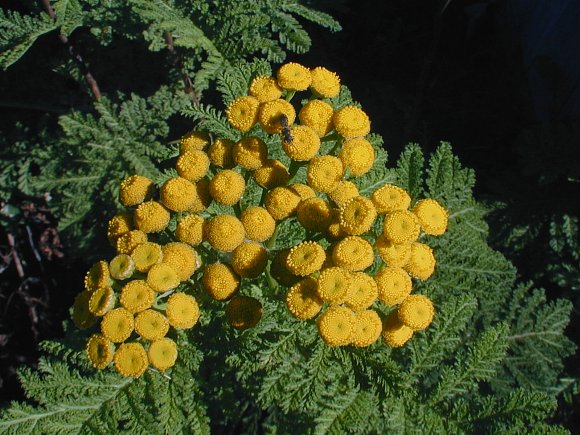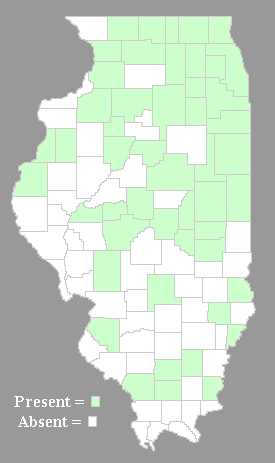Description: This herbaceous perennial plant is 2-4' tall, branching occasionally. The stems are glabrous or sparingly hairy. The alternate leaves are up to 12" long and 4" across, and more or less ovate in outline. They are double or triple pinnately lobed, which provides them with a fern-like appearance. In var. crispum, as revealed in the photograph below, the margins of these lobes are curled, whereas in the typical variety these margins are flat. The smallest lobes are dentate along the margins. The leaves have flat petioles and they are largely hairless.

The upper stems
terminate in flat clusters of 20-200 yellow flowerheads. Each
flowerhead is about 1/3" (8 mm.) across, consisting of numerous yellow
disk
florets and no ray florets (or insignificant ones). Each disk floret is
narrowly tubular and has 5 lobes that are upright, rather than
spreading, when it is fully open. The outer disk florets bloom ahead of
the inner disk disk florets. Each flowerhead is flat-topped and shaped
like a button. A single series of overlapping floral bracts surround
the base of the flowerhead. Each bract is green, oblong-linear in
shape, and often has a papery upper margin. The blooming period occurs
from mid-summer to early fall and lasts about 1-2 months. Whatever
fragrance the flowerheads may possess is overwhelmed by the strong odor
of the foliage. This odor is camphor-like and somewhat rank. Each disk
floret is replaced by an oblong greyish brown achene that often has a
tiny crown of scales at its apex. The achenes never have tufts of
hairs. The root system is fibrous and produces rhizomes. This plant
often forms vegetative colonies.
Cultivation:
The preference is full or partial sun and moist to slightly dry
conditions. Common Tansy does well in ordinary garden soil containing
loam or clay-loam. It is little bothered by pests and disease, although
some of the lower leaves may shrivel up and turn brown during a summer
drought. After the blooming period, the substantial foliage begins to
turn brown in patches and becomes ragged-looking in
appearance. 
Range & Habitat:
Common Tansy occurs occasionally in the northern half of Illinois, but
it is uncommon or absent in the southern half of the state. It was
introduced into the United States from Europe as an ornamental plant
and medicinal herb. Habitats include edges of prairies and fields,
fence rows, pastures, weedy meadows, old homestead sites, landfills and
soil piles, and areas along roads and railroads. The rhizomes can
survive earth-moving operations to produce new plants. This
old-fashioned plant is still grown in flower gardens, although it is
less common than before. Because of its ornamental foliage, var.
crispum is often grown in gardens, while the more typical
Common Tansy with flat leaves is the variety that is usually found
outside of gardens in natural and disturbed habitats. Sometimes this
plant spreads aggressively in pastures because cattle are reluctant to
eat the foliage.
Faunal Associations:
The nectar and pollen of the flowerheads attract small bees, flies,
wasps, and other insects. In Europe, there are several species of moths
(mainly Agrostis spp.) and other insects that feed
on the foliage of Common Tansy, but this plant has fewer insect pests
in North America. Because the foliage is bitter-tasting and toxic,
mammalian herbivores usually avoid this plant as a food source. Some of
the chemicals in the foliage include the insecticide pyrethrin, the
neurotoxin thujone, the toxic oil tanacetin, and camphor. If dairy
cattle eat the foliage, their milk acquires an unpleasant taste.
Photographic Location:
Along a back alley in Urbana, Illinois.
Comments:
In the past, Common Tansy was used to eliminate parasitic worms from
the digestive tract. Sometimes it was also used as an aborticide,
sometimes with fatal results. Because of the toxic substances in the
foliage, it is probably unwise to ingest herbal preparations from this
plant. Common Tansy is often associated with death, in part because its
flowering stems were used at funerals to repel flies from the deceased.
There are native Tanacetum spp. (Tansies), but they
don't occur in Illinois. The native Tansies are often smaller plants
with flowerheads that are larger in size, but fewer in number. Their
foliage is flat or curled, depending on the species.